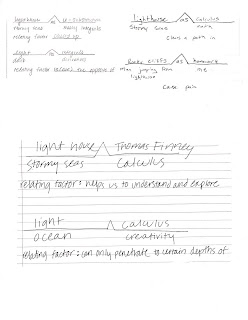


Teacher S and I are working on using NUA strategies to help students compare and contrast the definitions and notations for lines, rays, line segments, angles, and triangles. The problem seems to be one of literacy, so we are approaching the lessons with an emphasis on vocabulary development using circle maps, defining format, a list-group-label activity, tree maps, and some activities involving movement. Perhaps we will use a double-bubble as well.
The first activity was to ask students to create 4 different circle maps - one for each of the words line, line segment, ray, and angle. The were asked to write down words or pictures or symbols related to the given word. After about 8 minutes, students were asked to stand up and walk to the poster paper hanging at the front of the room and write down one of their words on the corresponding circle map. The circle maps for ray and line segment are shown in the pictures. We forgot to write the given word in the circle in the center, and we did not discuss the frame. We should have. These were mistakes simply because we are beginners at this! A good question for the frame could have been “What words or symbols come to mind when you see the word ray?”
As in the volume circle maps, there are many associations with the word ray that are not a part of the formal geometric definition of ray. However, having a time and place to write those associations and see them seems to be helpful because it acknowledges that the students have previous experience with the word ray. It is not until day 2 that we will formally define ray using the defining format.
After discussing various words and symbols and the circle maps we moved to a 10 minute post-it note activity. Five diagrams were already drawn on the whiteboard that consisted of a large variety of lines, line segments, rays, angles, and triangles. Each student was given 5 post-it notes. Their work was to find an example of a line segment somewhere in one of the diagrams and to write the formal notation for it on the first post it note. They did the same for line, ray, etc. Next, the students walked to the whiteboard and stuck their post-it notes directly on the segments, rays, etc, they described. This was a great assessment tool for the teacher! Teacher S could quickly see whether or not the class could correctly identify and label the 5 geometric literacy terms of the lesson. He could also see common errors and share them with the class. Everybody participated and yet nobody was singled out by not having complete comprehension. See the corresponding picture.

 These multi-flow maps were used in an Advaned Algebra class to help connect the relationships between matrices and transformations. The students were given the blank maps and filled them in as the unit progressed. This is an example of Thinking Maps being used as graphic organizers. The students reported they found it very helpful.
These multi-flow maps were used in an Advaned Algebra class to help connect the relationships between matrices and transformations. The students were given the blank maps and filled them in as the unit progressed. This is an example of Thinking Maps being used as graphic organizers. The students reported they found it very helpful.










